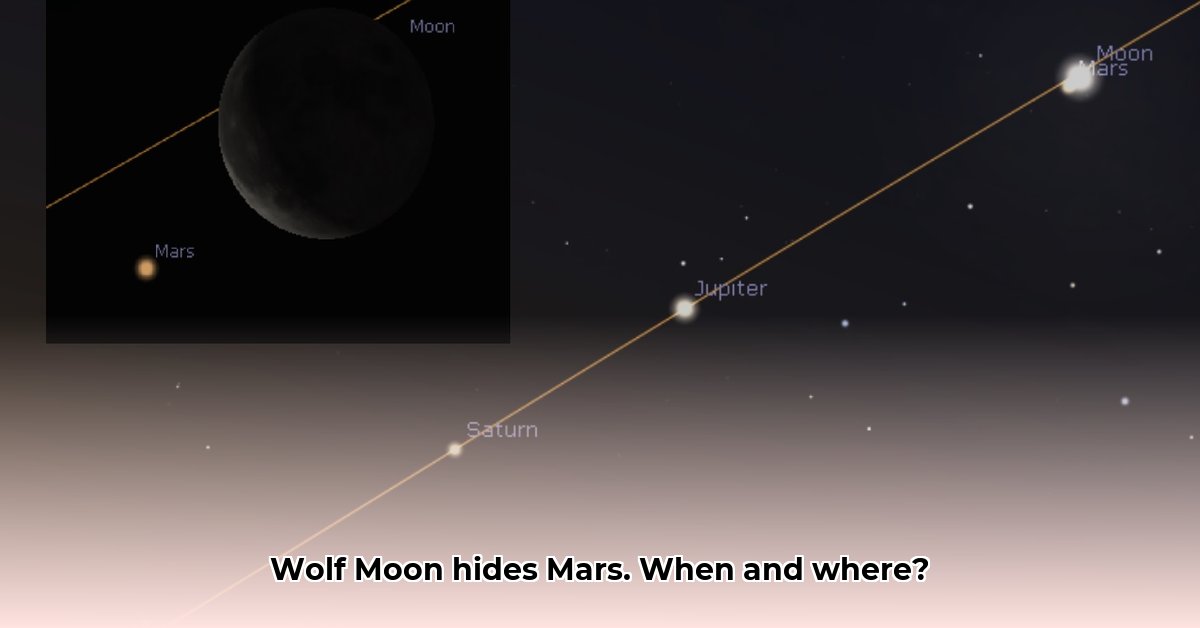Witnessing a celestial body disappear behind another is a truly remarkable sight. On January 13, 2025, the Wolf Moon, the first full moon of the year, treated skywatchers in certain locations to a rare spectacle: a lunar occultation of Mars. This means the Moon passed directly in front of Mars, making the Red Planet seemingly vanish from the night sky for a period of time. Just how long did this cosmic hide-and-seek last, and where could you see it? Let’s explore.
Understanding the 2025 Wolf Moon Occultation of Mars
A lunar occultation occurs when the Moon, in its orbit around Earth, passes in front of a more distant celestial object, like a star or planet. In this case, it was Mars that took a temporary dip behind the lunar curtain. This wasn’t a global event; its visibility and duration depended heavily on your location. Think of it like a solar eclipse – only certain areas on Earth experience the full effect.
The 2025 occultation offered a fantastic viewing opportunity for a large portion of North America, parts of Europe, western Russia, and North Africa. For those in the right spots, this event was primarily visible to the naked eye, but binoculars or a telescope would have provided a truly spectacular close-up view.
Pinpointing Your Local Occultation Times: A Step-by-Step Guide
While news articles and general astronomy resources may have mentioned the event, the exact times for your locale likely required some digging. That’s where online tools like In-The-Sky.org and Stellarium-Web.org become invaluable. These resources allow you to input your specific location and generate a personalized viewing schedule.
Here’s how you could have found the occultation times for your area:
- Choose Your Platform: Visit either In-The-Sky.org or Stellarium-Web.org. Both are user-friendly, even for astronomy novices.
- Set Your Location: Enter your city, state (if applicable), or for the most accurate results, your precise latitude and longitude coordinates.
- Specify the Date: Set the date to January 13-14, 2025. These sites act like time machines, letting you look back at past celestial events.
- Find the Event: Search or browse for the lunar occultation of Mars on that date. It should appear in the list of astronomical events for that period.
- Note the Timings: The site will display the start and end times of the occultation as seen from your location. The time between these two points is the duration of the occultation you would have experienced.
Example:
Let’s say you were in New York City. Using these online tools would likely have shown the occultation starting around 11:40 PM EST on January 13th and ending around 12:40 AM EST on January 14th, for a duration of approximately one hour. However, just a few hundred miles away, the times and duration could have been noticeably different.
Occultation Visibility and Duration: A General Overview
While precise timings were location-dependent, the 2025 Wolf Moon occultation provided roughly an hour of Mars disappearing behind the Moon for optimally placed viewers. Eastern Alaska likely had the best viewing conditions, while other parts of North America, Europe, western Russia, and North Africa also witnessed the event.
Here’s a generalized overview:
- Event Date: January 13-14, 2025
- Approximate Maximum Duration: ~1 hour (varied regionally)
- Prime Viewing Locations: Eastern Alaska, much of North America, parts of Europe, western Russia, and North Africa.
Viewing the Occultation: Tips and Considerations
For those in the visibility zone, the occultation was likely clear enough to see without any special equipment. However:
- Binoculars or a telescope would have offered a more magnified view of the Moon’s surface as it passed in front of Mars, making the event even more striking.
- Clear skies are essential for any astronomical observation. Check your local weather forecast before venturing out.
- Finding a dark location away from city lights greatly enhances the viewing experience.
The Science Behind the Spectacle
Lunar occultations aren’t just visually stunning. They provide significant scientific data as well. Astronomers use these events to refine calculations related to lunar and planetary orbits. Some researchers even study the light from a star or planet as it passes behind the Moon to learn about the object’s atmosphere.
Beyond the 2025 Event: Exploring Future Occultations
While the 2025 Wolf Moon occultation of Mars has passed, there will be other occultations in the future, involving various celestial objects. Websites like timeanddate.com offer information about upcoming astronomical events, including future occultations. You can also explore online forums and astronomy communities for discussions and predictions.
Keep in mind that our understanding of lunar occultations is always being refined as scientists learn more. Ongoing research explores the use of occultations to measure planetary sizes more accurately, and even to study the lunar limb (the edge of the Moon’s visible disk).
Remember to keep looking up! The universe is filled with wonders waiting to be discovered.







